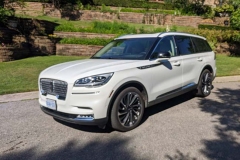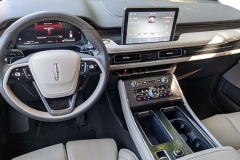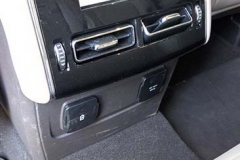2020 Lincoln Aviator test drive
After a week long test drive of the 2020 Lincoln Aviator, I have to admit I am more than a little impressed.
Lincoln’s newest SUV is based on the Ford Explorer platform but don’t be mistaken, this isn’t a dressed up Explorer. 
As with almost all manufacturers these days, vehicle platforms are developed to share within automotive group and alliances. Beyond the basic underpinnings, manufacturers have quite a bit of latitude to work with the development of a particular model.
The Lincoln Aviator looks the part of premium SUV thanks to sharp, Euro-inspired styling. A quick glance actually brings to mind Range Rover, a brand that once belonged to Ford. The glistening chrome and steel bits as well as the stylish 22 inch wheels, enhance the premium looks of this upscale SUV.
The interior of the Aviator is as impressive as the exterior. A massive glass roof with retractable sunroof and sunshade, bathes the interior in natural sunlight and provides an air of spaciousness. The dash is well laid out with a clean design centered on a centrally placed 10.25 inch touch-screen LCD panel. Push-button controls for gear selection sit beneath that. Basic audio control buttons and dials as well as climate controls punctuate the beginning of the center console and armrest, which houses a pair of large cup holders, cellphone storage and cavernous storage area under the armrest. 
Beautiful and supple leather surfaces cover the 30-way adjustable seats that also feature a variable massage feature for each of the front seats as well as heated and ventilated surfaces. One feature I liked was the split thigh support on the seat bottom. Each leg support was individually adjustable. One negative I did experience with the seating were the side bolsters. I am probably on the thinner side of average for someone in the target demographic for the vehicle and found the driver’s seat back quite tight. After checking the seat setting hidden in the dash-mounted LCD, I realized that seat side bolsters were already set as wide as they could go. Yes, they hold you firmly in place during cornering but this isn’t that sort of vehicle. It’s a tad soft and heavy for that level of sporty driving.
The Aviator has three rows of leather seating. The middle row can be ordered as buckets or a bench arrangement to increase passenger capacity from 6 to 7. The middle row has been designed for typical adult passenger comfort with the third row supplanted for compact kids and more agile, full sized adults in a pinch. The rear seats are electronically raised or lowered, while the second row can be manually folded down to enhance the utility of the Aviator to suits operators needs. With all seats in place, the Aviator provides 519L of storage, third row folded, 1,183L and with both rows folded, 2,200L of storage are available. 
The Aviator comes with a drive select mode, however that still doesn’t elevate the vehicle dynamics to mimic the sports sedans or SUVs that are specifically engineered for sharper handling.
The twin turbocharged 3.0 litre V6 engine produces 400 horsepower and 415 lb.-ft. of torque and is mated to a 10 speed automatic transmission. As you would expect acceleration is brisk and the highly efficient transmission rewards with buttery smooth shifts and logically works out just which of the tightly spaced gears best suits the power output of the engine. One of the few complaints with the power-train was with the transmission selector onboard. Instead of a console planted lever or steering mounted stalk, the Lincoln Aviator utilizes a push button selector located between the dashboard and centre console. The issue comes with the somewhat frequent occurrence of not properly changing gears if the vehicle hasn’t come to a complete stop, you won’t get reverse, instead you’ll still be in drive and if you hit the gas, you’re going forward not backwards. The extra process to confirm seems a silly complaint but one you don’t have with a physical selector.
Another feature on the vehicle that seemed enlightened at first but became annoying as it kept intervening was the proximity warning system included in the enhanced Co-Pilot 360 Plus package. Co-Pilot 360 comes standard on all Lincolns but the Plus package includes enhancements to improve the adaptive cruise control system and traffic assist input for the navigation system. The proximity warning system kept stopping the Aviator in my driveway as it is lined with trees on one side.
Those few issues a aside, the Lincoln Aviator steps up Lincoln’s presence in a crowded Luxury SUV market. Make no mistake, this a legitimate challenger in the segment. The price tag may shock some looking at Lincoln for the first time in a long while. The base price of the Aviator was $69,900 for the AWD standard to Canada model. However, our test vehicle carried a list price of $84,600 which included $15,600 worth of package options that didn’t affect the power-train. This price puts it squarely into a market of established European and Japanese luxury SUV’s. Content wise and with its level of refinement, the 2020 Lincoln Aviator stands up to anything in this price bracket. Hopefully buyers feel that the brand can bear this cost as the product certainly compares well with others in the luxury market.
Copyright © Auto Reviews Online 2016 | Privacy & Terms of Use | info@autoreviewsonline.com | Website by Brolly Media






